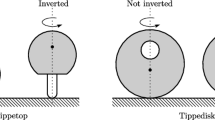Air viscosity makes the rolling speed of a disk go up as its energy goes down.
Abstract
It is a fact of common experience that if a circular disk (for example, a penny) is spun upon a table, then ultimately it comes to rest quite abruptly, the final stage of motion being characterized by a shudder and a whirring sound of rapidly increasing frequency. As the disk rolls on its rim, the point P of rolling contact describes a circle with angular velocity Ω. In the classical (non-dissipative) theory1, Ω is constant and the motion persists forever, in stark conflict with observation. Here I show that viscous dissipation in the thin layer of air between the disk and the table is sufficient to account for the observed abruptness of the settling process, during which, paradoxically, Ω increases without limit. I analyse the nature of this ‘finite-time singularity’, and show how it must be resolved.


Similar content being viewed by others
References
Pars, L. A. Treatise on Analytical Dynamics (Heinemann, London, 1965).
Euler, L. Theoria Motus Corporum Solidorum Seu Rigidorum (Greifswald, 1765).
Author information
Authors and Affiliations
Corresponding author
Rights and permissions
About this article
Cite this article
Moffatt, H. Euler's disk and its finite-time singularity. Nature 404, 833–834 (2000). https://doi.org/10.1038/35009017
Issue Date:
DOI: https://doi.org/10.1038/35009017
- Springer Nature Limited
This article is cited by
-
A wireless haptic interface for programmable patterns of touch across large areas of the skin
Nature Electronics (2022)
-
Dynamics of a vibration-driven single disk
Scientific Reports (2021)
-
Model reduction of the tippedisk: a path to the full analysis
Nonlinear Dynamics (2021)
-
Continuous rolling motion of a disk on a vibrating plate
Nonlinear Dynamics (2020)
-
Zeno chattering of rigid bodies with multiple point contacts
Nonlinear Dynamics (2018)





